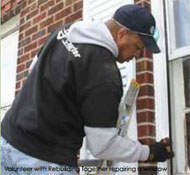Conduct A Weatherization Training Program
Weatherization or weatherproofing is the process of protecting a building and its interior to reduce energy use and lower energy costs
Description

Weatherization or weatherproofing is the process of protecting a building and its interior from the elements, particularly from sun, rain, and wind to reduce energy use and lower energy costs. In the US, buildings use one third of all energy consumed, so improving energy efficiency in buildings can have a great impact on overall energy consumption. Home weatherization is supported by many organizations nationally and locally. Organizing a block, street, or neighborhood to create a holistic and effective program will bring benefits to individual homeowners and the neighborhood as a whole.
Related Tools
When paired with other tools, hosting a weatherization workday can contribute to a more efficient, holistic, and energy saving neighborhood. Think about local prosperity, energy efficiency, and healthy communities. Try combining this tool with:
Community Projects
Add your project
Neighborhood Benefits
Environmental
- Increased awareness of weatherization and its benefits
- Reduced energy consumption associated with heating and cooling
- Reduced energy demands and decreased stress on the power grid
- Reduced air pollution associated with power plant emissions
Social
- Shared knowledge of weatherization tips and practices
- Lower-income families protected from rising energy prices
- Lower-income families have more free income to spend elsewhere or on other necessities
- Stronger community relationships
Economic
- Reduced utility bills associated with heating and cooling
- Increased available income to be saved
Get Started
- Research Speak with environmental experts, building contractors, and residents to determine realistic goals and budgets for the homes in your area.
- Collaborate Work with existing programs that focus on weatherization and energy efficiency such as the Urban League of Metropolitan St. Louis, the Community Action Agency of St. Louis County, Laclede Gas, Ameren, Rebuilding Together St. Louis, the Affordable Housing Commission, and the MO Department of Natural Resources. These organizations may be able to give you advice on executing your project, suggest opportunities for obtaining funding, and describe how to take advantage of federal tax credits.
- Collaborate Work with architects and contractors who have experience in designing energy efficient homes. Experts will know how to install energy efficient materials correctly and be sure you are maximizing the investment in your home.
- Permit Once your proposed design is complete, get the proper permissions and permits necessary for construction through the Building Division.
- Prepare Collaborate with neighbors on purchasing raw materials for your project. If one resident needs to buy insulation, most likely others do too;and you may be able to save money by buying these materials in bulk or by reducing shipping costs. Approach construction good supply stores such as Lowe's or Home Depot to see if there are discounts available to neighborhood organizations or non-profits, or if they will sponsor your workday event with supply donations.
- Fund Visit Set the PACE St. Louis to learn about possible funding opportunities.
- Work Take advantage of the labor pool of your neighborhood by determining what skills are available and see if members of your community are willing to volunteer or provide services at a low cost. Host an installation workday where neighbors of all ages help each other complete weatherization projects and learn about the benefits of making buildings fit for their environment. Be aware that you may need to hire experts to do work that requires expertise, specialized tools, or may be unsafe to complete on your own.
Opportunities
- Document and Publicize Discuss energy savings with your neighbors and encourage others to take advantage of the cost reduction and environmental benefits of selecting energy efficient products and weatherizing their home. Document your reduction in energy costs and share the data with your neighbors.
- Create a Tour Consider starting a guided or self-guided walking tour of your neighborhood, highlighting to visitors how easy it can be to update their homes to be energy efficient.
Related Categories
Sustainability Plan Categories
Project Scale
- Block
- Neighborhood
- Private Site
- Public Building
Download This Tool
Create a Weatherization Training Program Doc (258.04 KB pdf)
Need Help Viewing?
You need a program that can open Adobe PDF files. A free option:
- Adobe Reader can read PDF files
Help Us Improve This Page
Did you notice an error? Is there information that you expected to find on this page, but didn't? Let us know below, and we'll work on it.
Feedback is anonymous.